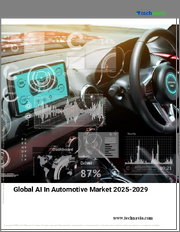
|
시장보고서
상품코드
1479965
중국의 자동차 성장 기회, 전망(2024년)Chinese Automotive Growth Opportunities, Outlook for 2024 |
||||||
Huawei의 업계 횡단적 파트너십은 전기자동차 업계의 통합을 강화
본 조사에서는 세단, 스포츠 다목적차, 다목적차, 크로스오버차 등의 승용차를 중심으로 중국의 자동차 산업에 대해 논의하고 있습니다. 또한 중국의 전기자동차(EV), 충전, 배터리 교환 인프라에 대해서도 평가하고 있습니다.
최근, 중국의 자동차 산업에서 가장 강력한 성장요인은 국내 OEM 브랜드의 부상과 EV의 장기적인 지속적 개선과 소비자의 수용 의욕입니다.
경제 상황, 특히 GDP 성장률은 중국의 자동차 산업에 큰 영향을 미치나, 정부의 장려(소비자 바우처 발행 및 대규모 자동차 쇼 개최 등)에 의해 판매는 개선하고 있습니다. 그러나 경기회복은 아직 완전하게는 재개하고 있지 않으며, 상대적인 불확실성을 초래하고 있습니다.
본 조사에서 Frost & Sullivan는 중국의 자동차 산업의 총규모와 2018-2024년의 과거 데이터와 예측 데이터를 제공합니다. 또한 아래 정보도 제공하고 있습니다 :
- 2023년 중국 자동차 산업의 하이라이트와 2024년의 미래 동향
- 차량과 파워트레인 하위 부문을 포함한 부문별 분석
- 중국내 브랜드의 부상에 관한 분석
목차
전략적 과제
- 왜 성장이 어려워지고 있는가?
- The Strategic Imperative 8(TM)
- 중국의 자동차 산업에서 상위 3 전략의 영향
- 성장 기회가 Growth Pipeline Engine(TM)을 촉진
성장 환경
- 2023년 : 총괄
- 2024년 : 상위 5 예측
- 중요한 규제와 의무
- 중요한 OEM 파트너십, 2023년
- 관련 부문에서의 신규 경쟁사, 2023년
세계 경제 전망, 2024년
- 상위 10 동향, 2024년
- 성장 기회 상위 10
- 세계의 GDP 성장률
- 인플레이션율과 금리
- 환율 동향
- 노동 시장
- 석유 산업
- 중요 광물 공급
- 북미
- 서유럽
- 중동
- 아시아
- 세계 경제 전망 대상국 리스트, 2024년
조사 범위, 세분화, 정의
- 분석 범위
- 세분화
- 정의
동향
- 중국의 자동차 산업을 촉진하는 상위 동향, 2023년
- 동향 1 : 국내 이해관계자의 부상
- 동향 2 : 합작 브랜드 재배치
- 동향 3 : L3 자율주행과 오토파일럿(NOA) 어반 내비게이트
지역 분석
- 성장 지표
- 소비 지표, 2023년
- 주요 조사 결과, 2023년
- 조사 결과 : 부문별, 2023년
- 출하대수 예측
- PV판매 동향, 2018-2023년
- 업계 점유율 분석
전망과 분석 : PV 부문별, 2024년
- 세단
- SUV
- MPV
- 크로스
전망과 분석 : 전기자동차 부문별, 2024년
- BEV
- PHEV
- 공공 EV 충전 포인트
- EV 배터리 교환소
결론과 전망
- 결론
- 향후 전망
성장 기회 유니버스
- 성장 기회 1 : 전기자동차의 성장
- 성장 기회 2 : 중국내 OEM의 부상
- 성장 기회 3 : EV 산업을 한층 더 파괴하는 컨버전스
부록
- 두자어·약어
- 자동차 OEM와 이해관계자 정식명칭
다음 스텝
- 다음 스텝
- 별지 리스트
- 면책사항
Huawei s Cross-industry Partnerships Will Strengthen Electric Vehicle Industry Integration
This study discusses the automotive industry in China, with a focus on passenger vehicles, including sedans, sports utility vehicles, multi-purpose vehicles, and crossover vehicles. The study also assesses the country's electric vehicle (EV), charging, and battery swapping infrastructure.
In recent years, the strongest growth factors in the Chinese automotive industry have been the rise of domestic OEM brands and the long-term continuous improvement of and consumer willingness to accept EVs.
Economic conditions, especially GDP growth, significantly affect the Chinese automotive industry, but with the government's encouragement (issuing consumer vouchers and holding large-scale automotive shows, for example), sales has improved. However, economic recovery has not yet fully resumed, causing relative uncertainty.
In this study, Frost & Sullivan provides the total size of the Chinese automotive industry and historical and forecast data from 2018 to 2024. It also offers the following information:
- Highlights of the Chinese automotive industry in 2023 and future trends in 2024.
- Analysis by segment, including the vehicle and powertrain subsegments.
- Analysis of the rise of Chinese domestic brands
Table of Contents
Strategic Imperatives
- Why is it Increasingly Difficult to Grow?
- The Strategic Imperative 8™
- The Impact of the Top 3 Strategic Imperatives on the Chinese Automotive Industry
- Growth Opportunities Fuel the Growth Pipeline Engine™
Growth Environment
- 2023: A Recap
- 2024: Top 5 Predictions
- Important Regulations and Mandates
- Important OEM Partnerships, 2023
- Emerging Competitors in Related Segments, 2023
Global Economic Outlook, 2024
- Top 10 Trends, 2024
- Top 10 Growth Opportunities
- Global GDP Growth
- Inflation and Interest Rates
- Currency Trajectory
- Labor Market
- Oil Industry
- Supply of Critical Minerals
- North America
- Western Europe
- The Middle East
- Asia
- List of Countries Covered in the Global Economic Outlook, 2024
Research Scope, Segmentation, and Definition
- Scope of Analysis
- Segmentation
- Definitions
Trends
- Top Trends that Drove the Chinese Automotive Industry in 2023
- Trend 1: Rise of Domestic Stakeholders
- Trend 2: Repositioning of Joint Venture Brands
- Trend 3: L3 Autonomous Driving and Urban Navigate of Autopilot (NOA)
Regional Analysis
- Growth Metrics
- Consumption Indicators, 2023
- Key Findings, 2023
- Findings by Segment, 2023
- Unit Shipment Forecast
- PV Sales Trends, 2018-2023
- Industry Share Analysis
Outlook and Analysis by PV Segment, 2024
- Sedans
- SUVs
- MPVs
- Cross
Outlook and Analysis by Electric Vehicle Segment, 2024
- BEVs
- PHEVs
- Public EV Charging Points
- EV Battery Swap Stations
Conclusions and Future Outlook
- Conclusions
- Future Outlook
Growth Opportunity Universe
- Growth Opportunity 1: Electric Vehicle Growth
- Growth Opportunity 2: Rising Chinese Domestic OEMs
- Growth Opportunity 3: Convergence Further Disrupting the EV Industry
Appendix
- Acronyms and Abbreviations
- Full Names of Automotive OEMs and Stakeholders
Next Steps
- Your Next Steps
- Your Next Steps
- List of Exhibits
- Legal Disclaimer



















